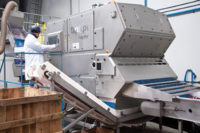Fresh, nutritious food options are available today in more places than ever before. And, food retailers are adapting their facilities to meet this consumer demand, with food processors following suit with fresh and convenient meal solutions. But, maintaining quality and food safety is a growing concern.
New food safety regulations
Preventing food loss and protecting customers from foodborne illnesses are critical concerns for food processors and their retail store customers. A single concern can negatively impact consumer perceptions, and in turn, affect a processor’s profits and reputation—a public health reality that prompted the passing of the Food Safety Modernization Act (FSMA) in 2011. FSMA marks the most significant food safety reform measure since the passing of the Food, Drug, and Cosmetic Act in 1938. It will have a dramatic impact on food processing manufacturers and producers nationwide.
The aim of the regulation is to better protect U.S. public health by strengthening the food safety system. This law enables the FDA to focus on preventing food safety problems, rather than relying primarily on reactive processes after problems occur.
Implications of FSMA
With FSMA, there is an increased responsibility on collecting and utilizing data, especially product temperature, to ensure that food remains fresh and safe from the farm to the manufacturer to the store to the consumer. Record keeping is a key component for FDA compliance, which means supply chain partners will need to ensure accurate, efficient documentation to verify the integrity of their foods.
As the regulations address the entire supply chain, not all provisions of this legislation apply to food processors. But, they should review the law and its provisions to understand the specific responsibilities and accountabilities placed on supply chain participants for actions and validation of processes. Food processors will need to work collaboratively with their suppliers, transportation carriers and retailers to ensure that all are aware of what’s needed for food safety compliance.
Consistency throughout the cold chain
Currently, a significant amount of data is being collected throughout the cold chain process – in harvest, processing, transportation, distribution and at the retailer – but, that data may be sitting separately at each point and not following the food to the next step; the data is captured but not shared.
This process has traditionally been fragmented, but connected solutions enable holistic insights and end-to-end food quality. By moving the data collected at each point into a cloud-based system, it can continue to be captured, stored and analyzed throughout the cold chain process, providing improved insights for more effective operations and informed food quality reporting.
Because of complex questions about data ownership and historic management of this data within specific applications, the insights and benefits to be gained from this data remain largely unrealized. However, it’s not difficult to envision in the not-too-distant future where processors and others can take advantage of a fully connected cold chain solution. That could include utilizing temperatures and other data to validate food safety and potentially creating competitive advantages by authenticating a fresh foods and processing story.
Best practices for safe food transportation
Maintaining food quality doesn’t end at the processor’s dock. Food processors can do their part to ensure food safety during the transportation phase of the cold chain. The following five temperature monitoring best practices can be leveraged throughout the transport of fresh foods to help create an effective program with FSMA in mind:
- Establish pre-cooling processes. Before food is transported, it should be pre-cooled by the processor to the correct transit temperatures, as this can have a direct impact on product quality, safety and shelf life. Pre-cooling should occur when the container is connected to the cold storage unit.
- Ensure proper loading practices. Perishable products should be loaded in a manner that allows airflow through the transport container, making sure that it does not go above the “load” line. Also, the product packaging itself should promote airflow.
- Develop and communicate proper transport temperatures. When the product is then shipped to distribution centers, it must remain within acceptable temperature ranges for the particular commodity (i.e., 56-62°F for bananas and 32-39°F for dairy).
- Integrate temperature monitoring device and placement procedures. Place a digital temperature-monitoring device on the product to provide the most accurate product temperature data. Establish consistent placement locations in all trailers.
- Check temperature data upon receipt at the distribution center. Once the shipment reaches the distribution center, quality assurance staff should check the temperature monitoring device’s data for any breaches. These devices provide historical information about what happened during transit, and can help identify any issues that may not be visible but could affect the future food quality and shelf life.
At this point, it would be the distribution center’s responsibility to continue product monitoring from their site to the store. While this segment of the cold chain is subject to similar food quality risks, independent monitoring devices are not always used to validate that product temperatures have been maintained. It’s recommended to use these devices along the process for a complete, continuous monitoring program.
Addressing food safety concerns
A good starting point for food processors is to fully understand the requirements of FSMA and key dynamics of the U.S. fresh foods landscape. Recognize and address the risks and vulnerabilities through an assessment of a processor’s internal systems and gain greater visibility into the supply chain.
As food processors work to achieve food safety standards and comply with FSMA, integrated controls and remote monitoring can assist with the management of facility systems to address potential food safety issues before products leave a processing facility.



